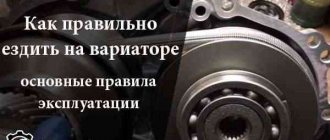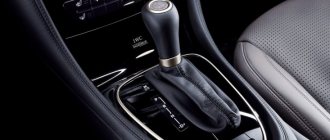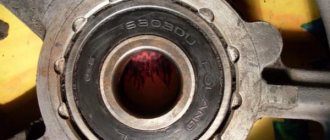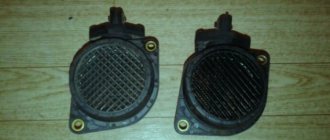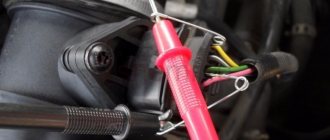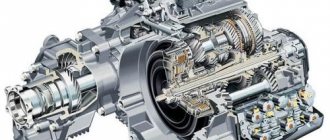The CVT helps save fuel and improve driving comfort. It is also easier and cheaper to manufacture than conventional automatic transmissions. However, continuously variable automatic transmissions have failed to take over the market. Not everyone is satisfied with the way the variator works, and - what's even worse - sometimes they break.
CVT is an abbreviation for Continuously Variable Transmission, which means continuously variable transmission. The CVT is an unusual transmission in many respects. Instead of classic gears, it uses a steel belt or chain that runs between two pairs of bevel wheels that form a pulley.
The wheels are mounted in pairs on the input and output shafts. Each bevel pair can move closer to each other or diverge, due to which the radius of the pulley changes infinitely, and a smooth change in the gear ratio is achieved. In this case, torque is continuously transmitted from the engine to the wheels.
When driving at a constant speed, the engine operates at unusually low speeds, which helps reduce fuel consumption and increase comfort. Users of cars with CVT emphasize the exceptional smoothness of movement - without jolts or jerks when starting. CVTs are usually smaller and lighter than classic automatic transmissions. Therefore, they are often used in small city cars, especially Japanese brands.
But if everything is so good, then why is the share of cars with CVT so small? It is quite difficult to single out the main reason. But many drivers are not satisfied with the specific operation of boxes of this type. You add gas, and the engine, howling loudly, reaches high speeds without noticeable acceleration. It only becomes quiet when moving at a constant speed. Car enthusiasts who like to press the gas pedal harder to the floor find this behavior of a passenger car annoying. However, this is mainly the case with continuously variable transmissions from the 80s and 90s.
About 10 years ago, CVTs with so-called virtual gears began to appear on the market. In this case, each gear is assigned a certain relative position of the bevel wheels. You can select the required gear, for example, using the steering wheel paddles (oars).
This solution has been used since 2005 in Audi vehicles equipped with the Multitronic continuously variable transmission. In normal mode, the box behaves like a classic CVT, i.e. Maintains high revs during acceleration. And the CVT simulates the operation of an automatic transmission only after switching to sports mode.
What is a variator
The CVT (abbreviation for Continuously Variable Transmission) is a mechanism that allows you to change the transmission ratio without transitions between stages. As a result, the car reacts smoothly to changing road conditions and driver signals.
Initially, such a device was invented by Leonardo da Vinci in the last years of the 15th century. But the issuance of an official patent for the mechanism was registered much later, which negatively affected the implementation of this principle in technology.
By the middle of the last century, CVT gearboxes were used on motorcycles. By the end of the century, the invention became in demand in aircraft construction.
The first car equipped with a CVT transmission rolled off the assembly line in 1958 at the DAF brand plant. The design of CVTs of those times was not reliable. The rubber belts wore out quickly, and the box required repair.
After a while, the Dutch engineer Hub Van Doorn used a steel flexible connection, which increased the reliability of the mechanism. Full production of cars with this transmission design began in the 80s of the last century.
Modern technologies involve the use of new wear-resistant materials and specialized lubricants. The design of the units has been structurally modified, hydraulic components and electronics have been optimized, which has increased the operational characteristics of the equipment.
Do you think the CVT can eventually supplant automatic and manual transmissions?
Yes
48.08%
Never!
51.92%
Voted: 52
Write in the comments!
What is X-Tronic CVT
The CVT X-Tronic V-belt transmission rolled off the assembly line for the first time in 2010. This was a continuously variable hybrid version of the classic automatic transmission in combination with a 2-speed CVT. Thanks to this design, Jatco was able to reduce the size of the cones and reduce the overall parameters of the transmission.
Early versions of CVT X-Tronic were equipped with cars with 2 and 3.5 liter engines. After modernizing the transmission, it became possible to install it on 1.6 liter models (for example, the new Renault Duster).
When modifying the variator, more than half of the gearbox elements were redesigned:
- pulleys have become more adapted to operation under high loads;
- the belt became aluminum, which had a positive effect on its ductility and service life;
- increased oil pump performance;
- The equipment now includes an Adaptive Shift Control (ASC) system, which allows you to adjust the transmission to the driver’s driving characteristics.
Unlike its predecessors (modification Jatco JF011E), the updated box (model JF015E) has reduced noise pollution (due to low-viscosity oil developed for the variator) and increased the service life of rubbing parts.
The modernization also affected the CVT firmware. Adaptive modes have been added (sports, for difficult roads, etc.). This made it possible to use CVT automatic transmissions in cars with high-power power units.
In 2014, the 8th generation variator was released - JF016E (installed on Renault Arcana), which in terms of hardware is reminiscent of the JF015E, but has some differences. The manufacturer abandoned the step motor (its function was taken over by solenoids-regulators), the operation of the valve body was also adjusted, the power range and the locking zone of the torque converter were expanded.
Do you think the modifications made really improved the performance of the CVT X-Tronic CVT? Write in the comments.
Varieties of CVTs
There are several types of gearboxes with CVT variators. The transmission is performed in the following design options:
- V-belt - includes a pair of pulleys connected by a trapezoidal belt. Each of the pulleys is made up of 2 disks, the working planes of which are inclined in opposite directions at an angle of 20°. Hydraulics regulate the distance between the discs. When the belt sag, the gear ratio changes, ensuring smooth operation. In modern models of CVT variators, the belt is made of high-strength steel plates, which guarantees reliable operation;
- wedge-shaped chain - with a chain connecting the individual shafts of the mechanism and assembled from several elements. The flexible connection is captured by cone-shaped disks, which allows you to transmit torque and change the gear ratio. The operation of the device is accompanied by heating from the contact of the chain with the disc sprockets, which are leveled by the cooling system. These mechanisms have high efficiency, but there is no reverse, which requires the use of additional components;
- toroidal - the design does not use a flexible connection. The mechanism consists of a pair of shafts with roller units installed between them. The change in speed occurs due to a change in the position of the rollers, and the moment is transmitted by the contact of the working surfaces.
The last type of CVT transmission listed above is used relatively rarely, but experts consider this design principle to be the most promising.
Design and principle of operation of CVT
Structurally, the CVT variator consists of:
- CVT transmission;
- reverse device for engaging reverse gear;
- a processor that controls the operation of the equipment;
- clutch that transmits torque and disconnects the box.
Clutch options in CVT gearbox:
- centrifugal;
- torque converter;
- multi-disc wet;
- electromagnetic.
The most commonly used option is a torque converter, which ensures smooth and silent operation.
The design of the CVT variator assumes an operating principle based on changing the gear ratio by moving apart the disks that form the input and output pulleys.
This is what it looks like on the diagram.
The mechanism begins to work after the driver selects a mode by switching the gearshift knob to the appropriate position.
The control processor regulates the position of the pulleys, depending on the speed of movement and the position of the accelerator pedal.
What is the difference between a variator and an automatic transmission and a robot?
The design and operating principle of a variable speed transmission (CVT) is different from an automatic transmission or a robot. All of the above mechanisms involve changing the gear ratio between the transmission with a minimum of driver participation.
The automatic transmission structurally includes a torque converter and a planetary gearbox. Due to these nodes, although a fixed gear ratio is maintained for certain positions, the process of transition between speeds is smoothed out.
The robot is a mechanic, controlled automatically when changing gears.
Bottom line
As it turns out from the article, there is nothing complicated in the operation of a cvt box. Many experts say that this is the future, but now this box has a long way to go to overcome the mistakes of the developers and improve its durability. As you can already assume, both manual and automatic transmissions went this way before it. Car enthusiasts can only follow its development today, and maybe in the near future, having corrected all the shortcomings, it will be able to completely replace the automatic transmission.
Pros and cons of a CVT gearbox
The CVT gearbox is supported by its strengths, but there are also several disadvantages.
Pros:
smooth change of speed, because even a torque converter automatic transmission does not exclude jerks when changing from one gear to another;
Extending engine life - proper operation of a car with a CVT, timely replacement of transmission fluid, and carrying out other work required by regulations reduces the load on the engine, which increases the service life of the power unit;
reduction in fuel consumption due to increased efficiency of the mechanism. The average efficiency value of CVT transmissions exceeds that of classic automatic transmissions by 7-10%;
environmental safety - the level of emissions of harmful substances into the atmosphere for cars with CVTs is lower than with other box design options;
rapid acceleration during acceleration - due to the continuous kinematic connection between the engine and the drive provided by the CVT transmission, loss of time on mode switching is eliminated. Therefore the car accelerates faster;
ease of control - the driver just needs to set the required mode to start driving.
Minuses:
difficulty in servicing - not all car services have specialists who understand CVTs, and repairing or replacing CVT units is not a cheap pleasure;
high cost of transmission fluid - such mechanisms require the use of certain brands of oil, sold at a high price;
the need to regularly replace the belt - a flexible connection lasts on average from 100 to 150 thousand km, and installing a new part is expensive;
relatively short service life of the unit, inferior to the service life of mechanisms of other designs;
increased risk due to improper operation.
What can cause malfunctions in the CVT box?
In addition to problems with the belt, failure of the CVT variator box can be caused by the following malfunctions: • wear of the working surfaces of the pulleys; • oil pump failure; • production of bearings on cones; • electronics failures, etc.
Identifying a malfunction requires detailed diagnostics of the CVT box and replacement of failed parts. Sometimes you have to completely change the variator, which will cost from 75,000 rubles. and more expensive.
This measure will be required if the belt breaks, the remains of which can destroy the unit beyond repair, or in case of other serious problems with the transmission.
If suddenly problems arise with the CVT gearbox, specialists from the “CVT Repair Center No. 1” will help you solve it. You can get a free consultation by calling: Moscow -, St. Petersburg - 8. We accept calls from all regions of the country.
We invite you to watch a video review comparing a CVT and an automatic transmission, as well as the advantages and disadvantages of a CVT transmission.
Cost of new and used Mitsubishi CVT
The price of the variator depends on the model. The cost of the W1CJA transmission on the secondary market reaches 84 thousand rubles, but you can find contract modifications for 55 thousand rubles. For the W1CJC model in used condition you will have to pay around 120-150 thousand rubles. The JF015E box is a little cheaper - you can really find good options at a price of 65 to 80 thousand rubles.
If you want to buy a new CVT, be prepared to pay 30-50% more than the cost of a used unit. Some models cost 200-300 thousand rubles, and replacing them is expensive.
How to drive a car with a CVT gearbox correctly
To extend the life of the CVT transmission, it is necessary to properly use a car with this box design. The owner should refrain from driving off-road. Wheel slipping when driving on snow or mud reduces the service life of the mechanism.
You should not suddenly run into obstacles, and switch from mode D to R as little as possible in order to reduce the wear rate of components.
You cannot tow a car with a CVT transmission, since forced movement damages the transmission. If towing is required, the drive pair of wheels must be suspended.
You should not use the car as a tractor or transport a trailer that weighs more than the established standards. More details about the features of driving a car with a CVT transmission design can be found in a separate article.
Reviews from car owners
To decide whether a CVT is really the best solution, or whether you should give preference to traditional gearboxes, you should read the reviews of car owners.
Sergey: “On my 2010 Outlander, there have never been any problems with the CVT; at most I change the oil, and the filters along with it, so as not to mess around with it twice later. The box is fast, it’s worth its price, at least I drive around the city and sometimes on the highway, it suits me.”
Peter: “If you don’t drive it too hard, the Jatco gearbox doesn’t cause any trouble. So young people may have problems with it, because they run around like crazy and start abruptly. It works for me, okay, I’ve been driving the Outlander XL for the second year now, and a lot, because the position demands it. All I did was change the oil.”
Maxim: “It seems that I was not as lucky as the others - once I had to replace some parts of the variator. I didn’t go into details, because I immediately handed over the car for service, it’s calmer and easier for me. The box itself is normal, it drives smoothly, doesn’t twitch, and there’s generally no discomfort.”
How to properly maintain a car with a CVT
The features of a CVT transmission require the owner to follow certain rules. It is necessary to provide:
- timely oil change. Use lubricant brands specified by the manufacturer or analogues with confirmed characteristics;
- regular computer diagnostics - in order to identify errors in the operation of the mechanism and electrical equipment;
- installation of new units to replace worn ones.
The owner must comply with the maintenance regulations established by the manufacturer and specified in the machine's operating manual.
The operating temperature of the variator must be maintained in the range from 70 to 105 degrees. Exceeding this indicator indicates unsatisfactory cooling of the equipment.
Reader questions with answers
There are many owners of Mitsubishi cars with Jatco continuously variable transmission, but most of them have the same questions. Below we will look at answers to popular queries.
Is it possible to install an additional radiator on a Mitsubishi with a CVT?
Yes, installing an additional radiator for cooling transmission oil is relevant, especially for the restyled Outlander XL, which does not have a heat exchanger from the factory. For installation you need a radiator, an o-ring, an automatic transmission filter, a thermostat, hoses and clamps.
CVT cooling radiator
How to determine that it is time to change the CVT gearbox?
Replacing the variator is a last resort measure that is taken if repairs are impractical in terms of effort, time and money. We are talking about serious damage: partial destruction of the body and internal mechanisms, severe clogging with chips, and so on.
How to repair a variator
CVT repair requires contacting specialized service stations with experienced craftsmen and the necessary equipment. Replacing any parts in the mechanism is impossible without dismantling and disassembling the unit.
The cost of repairing a CVT transmission depends on the severity of the breakdown. For example, the minimum costs for flushing the valve body valves and changing the oil (and this is a mandatory procedure for maintenance) will be:
- from 6 thousand rubles – for transmission fluid;
- from 10 thousand rubles – if replacement of valves is required;
- from 20 thousand rubles – to replace the hydraulic unit.
If a new car is under warranty, the CVT gearbox can be repaired free of charge at a service center of the corresponding brand.
Belts, bearings and other parts must be replaced. Pulleys can sometimes be repaired. But often it is necessary to change the flexible connection with disks and bearing units. As a result, the cost of such repairs is comparable to a complete replacement of the unit, which is more expedient in terms of the reliability and durability of the transmission.
Main malfunctions of the Mitsubishi variator
Despite the advantages, CVT gearboxes on Mitsubishi cars have a number of “diseases”:
failure of the oil pump pressure reducing valve;
overheating due to clogged heat exchanger filter;
wear and even complete destruction of bearings.
You don’t have to be a professional in car servicing to understand that the CVT is not working as intended by the manufacturer, and it’s time to send it to a service center for repairs. Next, we will consider the characteristic signs of failure.
Impaired ride
Do you notice jerks, jumps and twitches in your car while driving? Most likely, the oil pump pressure reducing valve has failed due to wear.
The pressure fluctuates, causing discrepancies in the operation of the pulleys. This leads to disruption of smooth running.
Oil pump pressure reducing valve
Creaking sounds in the variator
Rumble, creaking, metallic clanging, grinding and other extraneous sounds coming from the Mitsubishi variator are symptoms indicating severe wear or destruction of moving elements.
Often the culprits of extraneous sounds are the bearings of the cones on which the belt is worn.
Variator bearings
Belt variator
Cones and belt
Slowly gaining acceleration
If the car takes a long time to pick up speed, responds poorly and for a long time to pressing the accelerator pedal, and in general begins to drive worse than before, immediately contact a service center for diagnostics and further repairs. Waiting will only make problems worse.
How to extend the life of a variator
To extend the life of the CVT box, the owner must comply with the transmission maintenance regulations prescribed by the manufacturer: regularly change the oil, inspect the equipment.
It is necessary to adhere to driving rules that minimize wear on components in the car. At the first sign of malfunction, carry out diagnostics at a car service center. The technicians from the CVT Repair Center No. 1 will help you with this. You can get additional information or a free consultation by calling: Moscow -, St. Petersburg - 8. We accept calls from all regions of the country.




